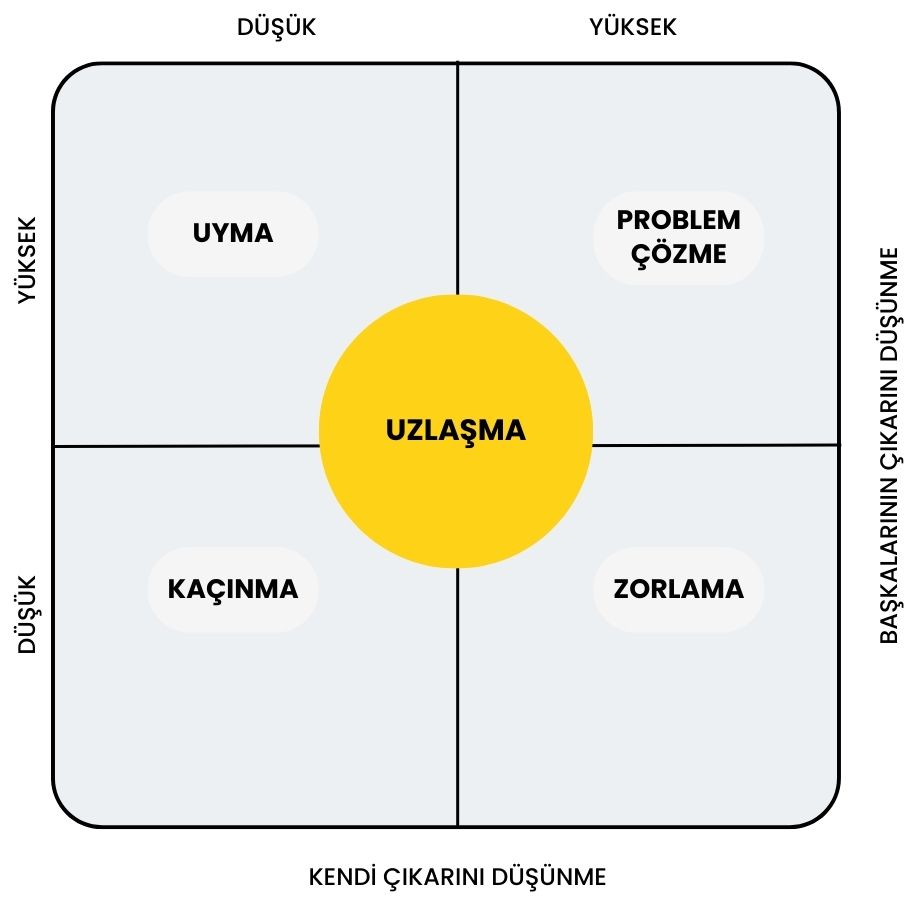
Workplace Relationships: Conflicts and Resolutions
Do you think “workplace conflicts” have a negative impact?
Are conflicts harmful and need to be resolved immediately, or is it possible to turn crises into opportunities? Research on these questions shows that there are various approaches to conflict from past to present. In the 1920s, conflict was considered an unnecessary process that harmed institutions and people and should be prevented. It was argued that conflict was harmful to organizations. Studies conducted at that time also support these hypotheses. Studies conducted at that time revealed that conflicts created communication gaps and distrust in individuals, and resulted in managers' insensitivity to the needs and wishes of employees. This idea continued to dominate until the 1940s. However, between 1940 and 1970, the perspective on the conflict began to change. Conflicts began to be accepted as more normal. In this period, conflict began to be treated not as a negative phenomenon as in previous years, but as a phenomenon that needed to be managed and that gave positive results when managed, but that had to be resolved. Since the 1970s, the approach to conflicts has changed more seriously and they began to be seen as a natural and necessary situation. It has begun to be thought that, up to a certain level, conflict has an effect that can increase the performance and creativity of individuals within the organization, but conflicts that intensify and are not managed effectively can harm the organization. According to this perspective, not all conflicts affect the organization in the same way. While some conflicts can support the goals of the organization and increase its performance, some can be destructive and harm the goals of the organization.
What are the types and causes of conflict?
There are different types of conflicts in the workplace. Conflicts can occur within an individual, between individuals, within a group, between groups and between organizations. The causes of conflict differ just like the types of conflict. Reasons for conflict;
- Personal differences, differences in goals and values, individuals feeling frustrated, status and power, etc. individual reasons it could be.
- Another reason for conflict is the size of the organization, how decisions are made, how the reward and recognition system works at work, and how employees are evaluated. due to structural reasons It may be due.
- Another reason for individuals' conflict is limited resources, uncertainty in job descriptions, or functional dependency. work related reasons it could be.
- Finally if communicative reasons is also among the factors that lead to conflict. Factors such as prejudices within the institution and lack of open communication are among the conflict factors caused by lack of communication.
If we want to be able to manage conflicts, it is necessary to determine the type and cause of conflicts in a healthy and accurate way. Conflicts do not arise out of thin air and have certain stages.
- Potential conflict: Represents the causes of conflict. Reasons such as resource limitations and power differences are considered under the potential conflict stage.
- Perceived Conflict: It occurs as a result of individuals misperceiving each other's real positions. In some cases, it may be possible for one to be unaware of the existence of an existing conflict.
- Felt Conflict: This stage refers to the emotional reactions of conflict between individuals. This may manifest itself clearly through emotional symptoms such as frustration, anxiety, tension, and hostile feelings that arise during conflict.
- Significant-Open Conflict: In this stage, conflict can openly emerge through actual behavior such as mutual argument, withdrawal of support, failure to communicate certain information and data to another person or group, or physical violence.
Determining the type, cause and stage of the existing conflict makes it easier to choose the most appropriate strategy to resolve that conflict. There are 5 different conflict resolution methods.

- Domination and Domination: This strategy represents an approach in which conflicts are resolved by using the authority and power of the manager.
- Compromise: It represents a solution approach in which parties in conflict try to reach a middle ground by compromising their own wishes and goals.
- Problem Solving/Collaboration: The problem solving method involves parties in conflict coming together to define the problem, review the reasons for the disagreement, offer alternative solutions, and choose a solution acceptable to both parties.
- Accommodation: In this strategy, one party prioritizes the interests and needs of the other party while putting its own interests and needs in the background.
- Avoidance: In this approach, the parties do not want to examine the reasons or logic of their addiction. They do not strive for cooperation, maintain a neutral attitude and avoid competitive situations. In this way, instead of resolving the conflict, they can further increase dependency and delay the resolution of problems.
In summary,
- Conflicts are not good or bad.
- It is required up to a certain level.
- When conflicts are managed well, they contribute to the progress of the organization.
- When they cannot be managed, they negatively affect the institution, employees and productivity.
- There are different conflict resolution strategies. However, these strategies cannot be used in every situation. A strategy should be implemented to address the conflict by evaluating the institutional climate.
- In order to resolve conflicts in a healthy way, the cause of the conflict must be determined correctly, the conflict must be defined, and the most appropriate strategy must be selected and implemented.
SOURCE
Aytaç, S. & Başol, O. (2018). VALIDITY AND RELIABILITY STUDY OF THE INTERPERSONAL CONFLICT SCALE IN THE WORKPLACE. Journal of Management Sciences, 16 (32), 471-484. Retrieved from https://dergipark.org.tr/en/pub/comuybd/issue/40668/433773
Rahim, M.A. (2002). “Toward A Theory Of Managing Organizational Conflict”, The International Journal Of Conflict Management, 13 (3), pp.206-235.
Rahim, M.A. (1983). Managing Conflict in Complex Organizations: in Karip, E. (1999), Conflict Management, Ankara: Pagem Publishing.
Solmuş, T. (2001), “Interpersonal-Intergroup Conflicts and Conflict Management in Organizations”, Turkish Psychology Bulletin, Issue: 20
Sütlü, T. ORGANIZATIONAL CONFLICT AND ITS EFFECTS ON EMPLOYEE.
Taştan, S. (2000). Management, Organization and Human Resources Management. Conflict and Conflict.



